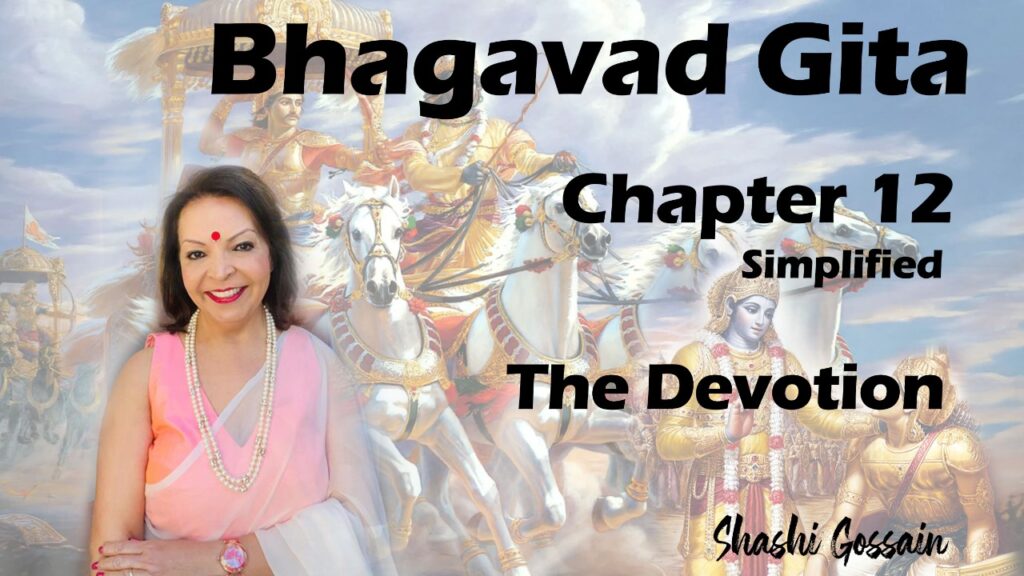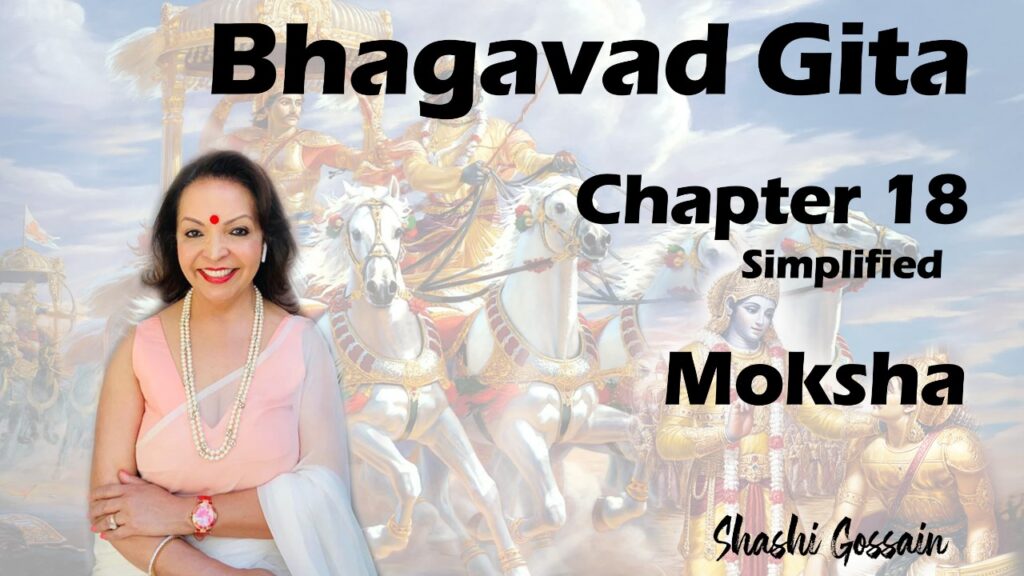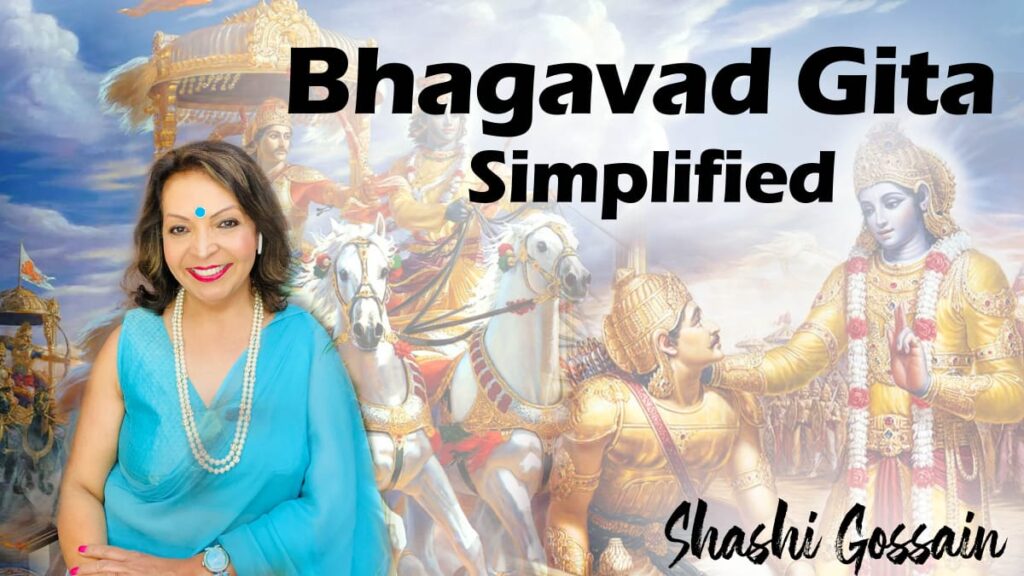Let us recap the chapters so far:
Chapter 1 of Geeta: addressed the confusion of Arjuna arising out of his lack of identity, and of not knowing his duty on the battlefield.
Chapters 2-5: explained what is the true nature of an individual, and using karma yoga to purify oneself.
Chapter 6: explained how to remain constantly in one’s true nature through dhyana yoga or yoga of meditation.
Chapters 7-10: gave us an elaborate description of Ishvara
Chapter 11: the vision of the cosmic form. Shri Krishna ended the previous chapter with the message that Ishvara is in everything, and everything is in Ishvara. But since our senses see the physical world and not Ishvara, we need a way to constantly be aware of Ishvara’s presence. Till we get to a state where this happens effortlessly, Shri Krishna asks us to take up the path of bhakti or devotion, where we constantly abide in the faith that Ishvara is in everything, and everything is in Ishvara.
What does bhakti mean in Hinduism?
Chapter 12 takes us to the Yoga of Devotion or Bhakti Yoga. The word bhakti comes from the root ‘bhaj’ meaning service. Dedicated action to Ishvara, who is in the form of dharma is called bhakti. Shri Krishna terms the teaching of this chapter as the “nectar of dharma”, or the “ultimate universal law of nature”. Arjun is still confused about the difference between “sannyasa” and “karma” and also on whoto worship. And Shri Krishna answers all his questions.
How does Krishna represent himself in the Gita?
Shri Krishna has described himself as imperishable, unmanifest, not visible to our senses, and he has created so many deities.
Who is the superior devotee?
Arjun wants to know,
who is the superior devotee?
Is it the one who worships the-
- Unmanifest: the invisible Lord or
- Manifest: the deities?
Shri Krishna answers that devotees who worship to the manifest are superior, as they find it easier to engage in worship.
A devotee who:
- Can fix his mind on Ishvara.
- Has the ability to remain constantly in worship, without diverting the mind.
- Has complete & unwavering faith
- Has the ability to concentrate his thoughts to penetrate & enter an object of concentration.
Shows supreme devotion, which is only possible by a purified mind, with a complete detachment from material desires. So to worship, the devotee fixes his mind to a deity or object and continually meditates about the object, then becomes one with the object. He loses all sense of selfishness. Nothing ever destabilizes his mind or his intellect. The devotee has merged with Ishvara and is at one with him. This is the final goal of devotion or bhakti. Shree Krishna wants to differentiate between the manifest (deities) & the unmanifest. Arjun wanted to know about the devotees who worship Ishvara as the unmanifest. Shri Krishnaji responds by firstly giving a list of adjectives to describe the formless Ishvara or “nirguna”. “Aksharam”: This does not decay, imperishable. The seeker negates everything that he encounters as perishable, so only the subject remains. “Anirdeshyam”: This cannot be described or defined by the speech and mind. “Avyaktam”: something that is invisble, not accessible to our senses “Sarvatragam”:which is not limited by space, and pervades everywhere and everything. “Achintyam” : which cannot be conceived as a thought by the mind. “Kootastha” : denotes changelessness in time. “Achalam” : changelessness in space. “Dhruvam” : which is eternal and deathless. If the seeker can imagine this, then the devotee can worship the formless Ishvara. The devotee does not consider Ishvara as separate from him with no expectations. Such a devotee loses all sense of selfishness. He revels in the welfare of everyone in this world. It is however, very difficult to worship Ishvara in his formless state, as our minds & eyes are conditioned to see a form. For this,
- We do not do any actions with motive e.g. monetary, emotional or intellectual wealth.
- Renounce all our actions to Ishvara, karma yoga, and leave the outcome to Ishvara. When we do this, our minds will not become destabilised with ups & downs of life.
- Our mind is then free to contemplate the higher goal of Ishvara.
This is can only happen with single-minded devotion, called “ananya yoga”. With constant worship of Ishvara through our body, mind and intellect, will lead to liberation of Sansaara, which in this context is the “ocean in which most people are stuck until their death, only to be reborn again.” The key condition is that we have to think of Ishvara as the ultimate goal and nothing else.
How do we reach God?
Shri Krishna describes four paths or yogas to attain Ishvara, with descending difficulty:
-
jnyaana yoga
- (Yoga of knowledge): the seeker should fix both his intellect and mind in Ishvara constantly, with one resolution: to merge with Ishvara. This is difficult, because the mind gets distracted very quickly. However, if this is difficult, The Lord says.
-
abhyaasa yoga:
- We first choose an object of worship such as the image of a deity, a spiritual text or a mantra. Then we should set aside a fixed time and place every day and meditate upon the object of worship. This has to be repeated to perfect the art, called “abhyaasa”. However, there has to be a complete dispassion towards the material world, as our mind will keep wondering.
The length of time can be gradually increased. Repetition daily will slowly train the mind.
- We first choose an object of worship such as the image of a deity, a spiritual text or a mantra. Then we should set aside a fixed time and place every day and meditate upon the object of worship. This has to be repeated to perfect the art, called “abhyaasa”. However, there has to be a complete dispassion towards the material world, as our mind will keep wondering.
-
bhakti yoga,
- (Yoga of devotion): we can remain connected to Ishvara for most of the time by making every act in our daily lives into an act of worship.
- shravana: constant listening of Ishvara’s glories
- kirtanam: chanting the names of Ishvara
- smaranam: constant remembering of Ishvara
- paadasevanam: bowing to Ishvara’s feet
- archanam: worshipping Ishvara in temples or in our own homes
- vandanam: offering prayers
- daasyam: considering ourselves as servants of Ishvara
- sakhyam: considering ourselves as friends of Ishvara
- aatmanivedana where we completely offer ourselves to Ishvara.
When every action including our work in the office, our chores at home, our studies in school and our dealings with friends and family becomes an act of worship, we slowly submit our ego into the altar of Ishvara.
Once our ego is completely demolished, we can prepare for abhyasa, and then jnyaaya yoga.
-
Karma yoga
For most of us, there are still material desires, in which case, Shri Krishna gives two simple suggestions:- do your best actions and submit the results of actions to him
- control the senses as much as possible to reduce the inflow of selfish desires
This is the most simple and basic spiritual technique that takes us one step closer to Ishvara.
In order for us to that access Ishvara, a series of stages of yoga were laid out, based on our qualifications. They were in descending order, addressing the most qualified to the least qualified.
- Jnyaana yoga: who have given up attachment to the body
- Abhyaasa yoga: who can sit for meditation
- Bhakti yoga: who can perform every action for Ishvara, and
-
Karma yoga: who can dedicate the results of their actions to Ishvara.
You can graduate to higher levels of understanding, with practise and goal-setting. An accomplished devotee essentially is convinced of two things that:- everything in this world is not different than Ishvara
- the devotee himself is also not different from Ishvara
So when there is such a universal sense of oneness with everything, the devotee becomes extremely friendly towards everyone. There is no sense of dislike or hatred present in him towards those who oppose him. He instantly forgives everyone. He is compassionate towards those who are in need. The mind does not get agitated in sorrowful situations, or excited in joyful situations. When all sense of duality is gone, it maintains a sense of equanimity. Most of us derive contentment from food, people, objects or situations in the world. Contentment is a state where the mind does not want anything else from the world. He has complete self-control over his mind, body & intellect and doesn’t run after short term happiness.
What kind of a devotee is very dear to Lord Krishna?
Few sholkas in this chapter are devoted to the type of devotees dear to Shri Krishnaji. Shri Krishna lists four common reactions-
- excitement on sensing anything pleasant
- irritation on hearing anything unpleasant
- fear on hearing something fearful
- agitation when meeting someone or anything that is disagreeable
Shri Krishna says that such a person who is free from all these transient emotions is dear to him. The perfected devotee is also a perfected karma yogi. His mind has been purged of selfish desires, leaving room only for actions pertaining to his duties or svadharma. He has understood the art of performing any action, big or small, in line with Shri Krishna’s teaching on karma yoga, thereby achieving perfection in action. He doesn’t undertake new initiatives if the action is not part of his svadharma. He has given up expectations about the result & dedicates the results of his actions to Ishvara. He performs all his actions, without distractions, but with utmost focus, perfection and without fear, as he has no mental agitations caused by future expectations or past anxiety. The perfected devotee accepts all objects and situations as Ishvara’s blessings.
He is unaffected by:
- Attraction/revulsion,
- Desire/hatred
- Joy/grief
Through intense devotion to Ishvara, the devotee can get stability of the devotee’s inner instrument or antahakarana, which is:
- Intellect
- Mind
- Senses
- Ego
- Memory
Our inner equipment contacts the world through the sense organs. The skin experiences heat and cold. This message is sent to the mind, where it is interpreted as joy/sorrow when its too hot or cold, based on our memory. If the skin sends a message of hotness, the mind feels joy in winter and sorrow in summer. Similarly, if we hear praise, we are joyful, whereas criticism gives us sorrow. This is due to attachment of the ego to the body, as it generates a strong positive or negative reaction in the mind. A devotee, who considers the body as a part of Ishvara’s creation, is unaffected. He remains silent. Silent to all desires & afflictions. The devotee is unattached to his house, his physical body, his mind, his intellect or his desires. He is called “naraha” or a true human being. Shri Krishna also highlighted that the devotee who performs all actions with unwavering faith, and has fixed Ishvara as the ultimate goal, or “matparamaahaa” is very dear to him. So, this chapter ends with a list of thirty nine qualities of a perfected devotee. They are meant to inspire us. Even if we cannot gain all these qualities, we should aim for acquiring at least one, because gaining even one quality opens the door to the acquiring the rest. In all of these qualities: equanimity, unselfishness, de-attachment and unwavering faith towards Ishvara are repeatedly emphasized.




Pingback: Bhagavad Gita Chapter 14: The Three Modes - Simple Hinduism